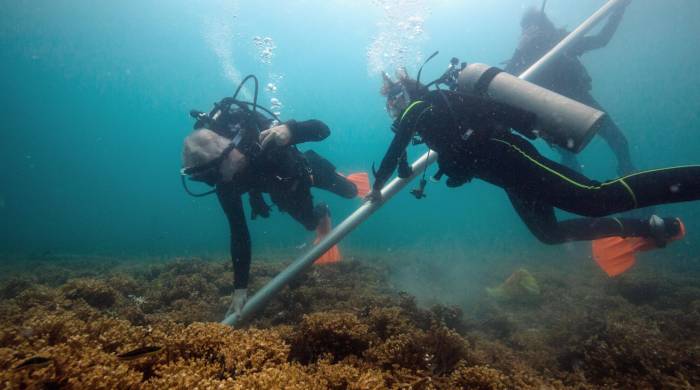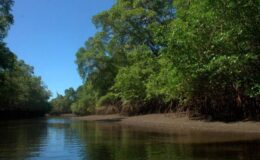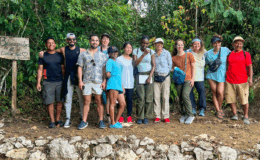Scientists look to past to try to save marine future in Panama.
- By : James Bryson
- Category : Conservation, Environmental

The Punta Culebra Natural Center of the Smithsonian Tropical Research Institute (STRI), located on the Amador Causeway, receives visitors and students from Panama and abroad. But few know that, a few meters away, is the O’Dea laboratory, where a group of scientists studies the wonders of the natural world.
Dr. Aaron O’Dea, biologist, marine paleontologist, researcher and member of the National Research System of the National Secretariat of Science, Technology and Innovation (Senacyt), leads the laboratory where an interdisciplinary team studies marine fossils. Kimberly García, marine biologist and laboratory administrator, explained that the study of these fossils allows us to know the past, understand the present and respond to current problems, such as coral bleaching and mass extinctions of organisms.
Through the study of fossils of corals, fish, sharks and other organisms, the past can be reconstructed, for example, the environmental changes that occurred, the evolutionary processes in fish communities and how marine ecosystems behaved before the human intervention.
Paleontology is a discipline that studies fossils in an attempt to reconstruct and understand natural history. Some people, when they hear the word ‘paleontology’, think only of dinosaurs, but there is a wide range of fossils that tell very interesting stories from their times.
The Isthmus of Panama was formed about 3 million years ago and did not have dinosaurs. However, its geological history makes it the perfect place to study marine fossils that provide amazing data from the past.
To address the different areas of study of the laboratory, it is necessary to extract fossil samples for analysis. This is achieved through a technique that consists of sticking a six-meter-long aluminum tube or core into the sea floor. The process is completely manual, requires several people and can take up to six hours to set.
Depending on the area, several tubes can be placed to collect various information, for example, on reefs and seagrasses.
The team usually stays in the field for two weeks, but analysis in the laboratory can take a year.
Just as in other latitudes ice cores are extracted to study climate changes through layers of snow accumulated and compacted over millennia, researchers at the O’Dea laboratory fill the tubes with sediments that contain fossils that can be up to 7,000 years old. antiquity.
After the core is extracted, scientists cut it in half with a saw and divide it into one-meter sections. “We found layers similar to those of a sweet or an onion, which have the entire history of a reef. The tubes are like the ‘black box’ of our seas with direct information from the past,” says Dr. O’Dea.
Fossils of corals, fish, otoliths, teeth and denticles of sharks, and other organisms are preserved in the sediment layers. It is estimated that for every meter of sediment there are a thousand years of history.
Sharks have denticles on their skin, they are like very small, tooth-shaped scales. When touching a shark’s skin to the side, the denticles feel rough like sandpaper. To the untrained eye, they look much more like a grain of sand than a flake. These small ‘scales’ are made of the same material that these animals’ teeth are made of. The denticles help them swim faster and protect themselves.
To analyze the denticles under the microscope, researchers pass the sediments through sieves of different mesh sizes to remove sand and impurities.
Erin Dillon, a doctoral student and STRI fellow , comes from the University of California, Santa Barbara to Panama to study these microscopic scales. Her goal is to rebuild shark communities using dermal denticles preserved in reef sediment. It is possible to determine the types of sharks that existed, at the functional group level, but it is very difficult to identify species.
Dillon shared that “studying shark denticles helps us understand what is natural in their communities, especially when compared to data from before human intervention.” This knowledge represents the first big step towards conservation.
Irene García, a marine biology and sociology student at the International Maritime University of Panama and the University of Panama, respectively, is an assistant on Erin Dillon’s project and seeks to investigate the complexities of the human-nature relationship over time. This includes the sociological, environmental system and ecological history.
“By studying the abundance of sharks we have, we can infer what the cultural relationship was between precolonial societies and the ecosystem.” Irene, from a sociological point of view, thinks that the evidence shows that balance between humans and the marine ecosystem is possible.
Shark communities are declining due to overfishing, climate change and other factors. One of the big problems continues to be how to translate paleontology data so that they can be used in conservation and public policies.
García commented that there are more denticles at the bottom of the tube and fewer at the top, this means that in the older past there were a greater number of sharks. One research question is, how might we understand the cultural relationship between the ocean and society?
Comparing shark communities and the rate of change over time can give us information about how it impacts the way we relate to the environment and what the effect of poverty and inequality in coastal areas is on ecological systems.
For her part, Brígida de García, a research technician and graduate in geography and history from the University of Panama, works identifying otoliths of reef fish. The word ‘otolith’ comes from the Greek otos (ear) and lithos (stone); These are structures inside a fish’s ear that help them with hearing, balance, and gravity.
For researchers, the study of otoliths helps them identify and map different species of fish. Unlike denticles, these can not only be found in the ocean, but are also found in geological formations such as Gatún.
Thanks to their composition and mineral coating, otoliths are excellently preserved over time, in fact, it is the only part of the fish that remains after thousands of years.
Otoliths are also excellent for determining the ocean conditions in which species lived, such as temperature and acidity, among others. They are a mirror of the seas of the past.
De Gracia commented that otoliths are “essential to recreate the paleoenvironment of many areas of the isthmus of Panama” and says that “beyond the mapping of species, they give us information about the history of the formation of the isthmus and the division of the Caribbean Sea.” from Pacific”.
Also in the O’Dea laboratory are Rodnyel Arosemena, a marine biologist and intern who works with fish otoliths and performs stable isotope analysis, and Lucía Morales, an intern who will do her thesis on fish.
Doing science is relatively easy compared to having that same science influence public environmental conservation policies. The O’Dea laboratory team hopes that in the coming years the population will learn more about the research projects that are being carried out in Panama.
Not only does it provide a fascinating glimpse into the marine past, but it also invites us to reflect on the future of our oceans and the importance of their conservation. Through rigorous research and public education, this laboratory contributes to the protection of our natural heritage for generations to come.



No Comments